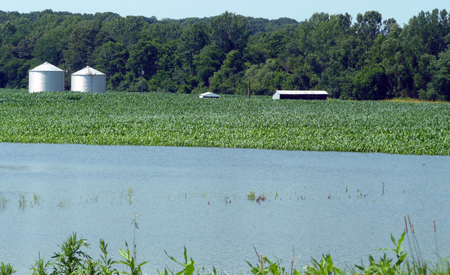Standing water from heavy rains? Consider investing in tile drainage.
Tile drainage can improve plant growth and speed surface drying, as well as increase the amount of water the soil can hold.
Parts of Michigan have been inundated by rain over the weekend, halting for a few days the great planting progress we’ve been making. On campus, our weekend rainfall totals exceeded 3 inches. Standing water is a big problem on research plots, so pumping and ditching is frequently the order of the day following heavy rainfall events.

Flooded corn field. Photo credit: "Michigan Sea Grant."
While flooding could be found in many of the usual places on campus – water over Bennett Road near the beef barn, a lake large enough to hold a sailing regatta at MSU’s Ag Expo – the rotation fields holding the wheat Fusarium head blight nursery didn’t have any standing water. This is one of the first places we typically need to start moving water and on Saturday morning (May 14), there were none of the typical temporary duck ponds. The difference this year? Last spring on that end of the farm, tile lines were repaired and additional lines installed. What a difference that work has made over the last couple of days.
Perhaps a valid use of time in the next few days is to visit fields to determine where water is slow to drain. Tile serves to lower the water table in the soil. This helps to improve plant growth and speed surface drying to allow field work, but also increases the amount of water the soil can hold before reaching saturation and ponding. The pores of flooded soil are completely filled with water, leaving no space for oxygen. In such an environment, a seed or plant is unable to respire and can perish relatively quickly. In flooded conditions resulting from this weekend’s rains, the cool forecasted temperatures will reduce respiration and extend seed survival. Tile systems can be crucial in quickly draining water and ensuring seed survival.
The necessary return on investment for tile drainage systems is always a concern when considering installation. This is particularly true for rented acres where questions of landowner or tenant payment, rental fee implications and length of the lease become factors. Iowa State University Extension’s Ag Decision Maker details many facets of tile drainage in Don Hofstrand’s article Understanding the Economics of Tile Drainage. This article hits on many economic factors in tile drainage and offers strategies to make installation feasible.
Quickly getting standing water off fields is just one benefit to tile drainage systems, but it’s probably the most dramatic and visual effect. These heavy rainfall events don’t have many positive benefits, certainly this time of year, but they do highlight where tile might have the most benefits. Let’s hope we don’t have many more “opportunities” like this again this spring.



 Print
Print Email
Email


